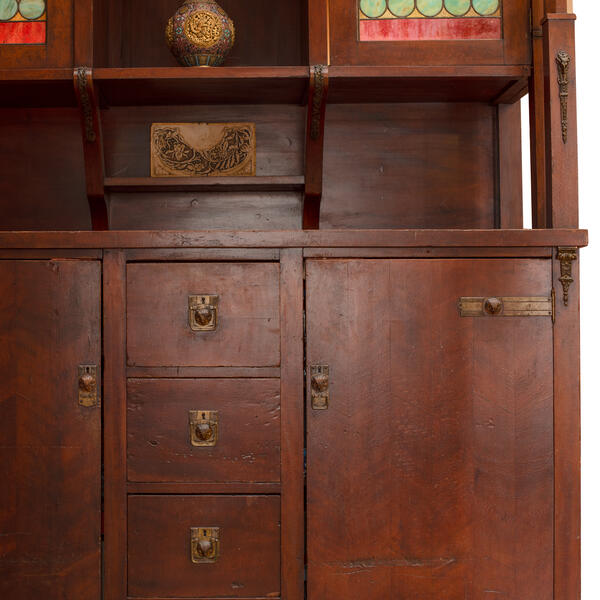The display cabinet with stained glass doors stands in the hall that was used as a grand dining room in the early 20th century. Next door was the grand drawing room. Through the tall double-leaf doors, guests could go outside onto the spacious terrace. The fence on the terrace was decorated with a geometric pattern that included spiral scrolls.
On the left side of the terrace, there was a staircase leading down to the adjacent garden. The décor of the dining room and terrace reflects the influence of the Art Nouveau style, which was popular in the late 19th and early 20th centuries.
The design of the display cabinet combines various characteristics of the Art Nouveau style, including the use of curved lines, motifs of nature and Eastern architecture, and the combination of various materials.
The furniture maker produced this display cabinet of oak, enhancing its design with stained glass and metal mounts shaped like the goddesses of glory with trumpets, as well as the heads of animals and birds. The cabinet’s silhouette was accentuated by smooth, curved lines, and its arched top was designed to resemble a pagoda.
The design of the display cabinet is typical of this kind of furniture: it consists of three sections. The shelves behind the glass doors in the upper section were designed to hold fragile tableware, wine bottles, or fruit vases. The lower and upper sections of the display cabinet are separated by a tabletop with a recess, which could be used for arranging a dish for being served. Larger tableware, including plates, bowls, and teapots, was stored in the closed compartments at the bottom.
The display cabinet also had cutlery trays. Storing various items was not the only function of the display cabinet. Often, it also served as a piece of interior décor. Each cabinetmaker decorated the furniture differently. Although all display cabinets followed the same principles of design, they varied in proportions and décor.
In cities, a luxurious display cabinet also served the additional function of reflecting the high social status of the owner and the wealth of the family. Such furniture was highly valued and often passed down in a family through generations.


